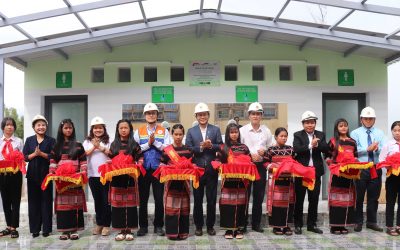
As major markets implement policies to drive the transition, measuring and transparently reporting emission reductions are essential to every company’s journey to Net-Zero. This article provides an overview of the necessary steps, from calculating emission baselines and data management systems to digital transformation. Additionally, it suggests effective and practical methods for manufacturing businesses.
1. Implementation methodology for businesses aiming for Net-Zero
In increasing climate change, businesses need specific and scientific solutions to achieve the Net-Zero goal: zero net greenhouse gas emissions. To achieve this, the first and most important step is to calculate and measure the company’s emission baseline.
- Calculating the emission baseline: Businesses need to use accurate measurement methods to determine their current emissions. This helps them comply with Net-Zero policies and commitments and ensures that emission reduction measures are tailored to the company’s specific context. For example, the Bangladesh Garment Manufacturers and Exporters Association (BGMEA) collaborated with the German International Cooperation Organization (GIZ) to build sustainable capacity for the garment sector. Part of this initiative includes measuring and assessing the emissions of garment factories, helping these businesses identify their emission baselines.
- Measurement and data management system (MRV): Once the emission baseline is identified, businesses must establish an effective measurement and data management system. This system helps monitor and track emissions throughout the implementation of mitigation measures, ensuring the Net-Zero journey stays on track. For example, many businesses in the Bangladesh garment industry have implemented environmental data management systems to track emissions and energy use, thereby effectively adjusting their production activities.
- Digital transformation in emission management: Digital transformation plays a crucial role in achieving green transformation. Applying digital technology helps measure and manage emissions more transparently and accurately. Businesses can use energy management software and data analytics tools to monitor emissions in real-time. This not only helps control emissions but also optimizes mitigation measures, ensuring transparency in emission reporting.
- Emission reduction projects and solutions: Businesses need to systematically implement emission reduction projects and solutions, measured in real-time. This helps adjust measures promptly to achieve optimal effectiveness in reducing greenhouse gas emissions. For example, emission reduction projects can include adopting cleaner production technologies, using renewable energy, or improving production processes to reduce energy consumption and greenhouse gas emissions. In the Bangladesh garment sector, many factories have started using high-efficiency machinery and smart energy management systems to minimize energy consumption and CO2 emissions.
To ensure the highest efficiency in emission measurement and data management systems, businesses should collaborate with reputable organizations. This not only helps build reliable management systems but also ensures that emission data is audited and certified by global audit organizations. These organizations can provide accurate certifications and reports, helping businesses gain acceptance in major markets.
 Overview of the Net-Zero journey by VP Carbon suggested for businesses
Overview of the Net-Zero journey by VP Carbon suggested for businesses
For example, businesses can partner with organizations like VP Carbon to develop the MRV platform and the entire measurement reporting chain. This not only enhances the business’s credibility but also ensures that its Net-Zero commitments are widely recognized, thereby facilitating participation in international markets.
2. Effective Net-Zero methods
Businesses can adopt various methods to achieve the Net-Zero goal. Here are some of the most effective approaches:
- Energy optimization: This is one of the easiest and most impactful measures. Businesses can implement smart HVAC (heating, ventilation, and air conditioning) systems, energy-efficient LED lighting, and motion sensors to reduce energy waste. Additionally, improving insulation systems and using energy-saving equipment are effective measures to optimize energy usage.
- Transition to solar energy systems: Installing solar panels on rooftops or company premises helps generate stable renewable energy and reduces reliance on the national grid. Businesses can also consider using storage systems to utilize surplus solar power, stabilize operations, sell a portion of the allowed production back to EVN, and reduce the regulatory pressure on the national grid system.
- Purchasing Renewable Energy Certificates (I-REC): Businesses can purchase I-RECs from reputable suppliers to offset electricity consumption from non-renewable sources. This not only demonstrates a commitment to green energy but also increases transparency and reliability in ESG reports. Recording and reporting the number of RECs purchased will be key to emission reduction strategies.
- Carbon credit trading: This is another effective method to achieve Net-Zero. Businesses can participate in the carbon credit market, where companies can buy and sell emission credits. This allows businesses to adjust their emissions and achieve Net-Zero efficiently and flexibly. Carbon credit trading also incentivizes businesses to reduce emissions and invest in environmental protection projects.
Vu Phong Energy Group









